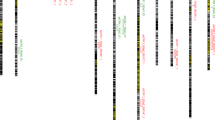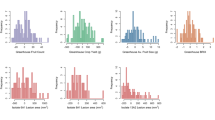Abstract
Bacterial spot of tomato (Solanum lycopersicum L.), caused by several Xanthomonas sp., is a serious but difficult disease to control by chemical means. Development of resistance has been hindered by emergence of races virulent to tomato, by the quantitative inheritance of resistance, and by a low correlation between seedling assays and resistance in the field. Resistance to multiple races, including race T4, has been described in the S. lycopersicum var. cerasiformae accession PI 114490. We used molecular markers to identify associations with quantitative trait loci (QTL) in an elite inbred backcross (IBC) population derived from OH 9242, PI 114490 and Fla. 7600, a breeding line with tomato accession Hawaii 7998 (H7998) in its pedigree. Race T4 resistance has also been described in the advanced breeding lines Fla. 8233, Fla. 8517, and Fla. 8326, and a selective genotyping approach was used to identify introgressions associated with resistance in segregating progeny derived from crosses with these lines. In the IBC population, loci on chromosomes 11 and 3, respectively, explained as much as 29.4 and 4.8% of resistance variation. Both these loci were also confirmed by selective genotyping: PI 114490 and H7998 alleles on chromosome 11 each provided resistance. The PI 114490 allele on chromosome 3 was confirmed in the Fla. 8517 population, and an allele of undetermined descent was confirmed at this locus in the Fla. 8326 population. A chromosome 12 allele was associated with susceptibility in the Fla. 8517 population. Additional loci contributing minor effects were also implicated in the IBC population or by selective genotyping. Selection for the major QTL in a marker-directed phenotyping approach should significantly improve the efficiency of breeding for resistance to bacterial spot race T4, although as yet undetected QTL would be necessary to carry out strict marker assisted selection.
Similar content being viewed by others
References
Astua-Monge G, Minsavage GV, Stall RE, Davis MJ, Bonas U, Jones JB (2000) Resistance of tomato and pepper to T3 strains of Xanthomonas campestris pv. vesicatoria is specified by a plant-inducible avirulence gene. Mol Plant Microbe Interact 13:911–921
Bouzar H, Jones JB, Minsavage GV, Stall RE, Scott JW (1994a) Proteins unique to phenotypically distinct groups of Xanthomonas campestris pv. vesicatoria revealed by silver staining. Phytopathology 84:39–44
Bouzar H, Jones JB, Stall RE, Hodge NC, Minsavage GV, Benedict AA, Alvarez AM (1994b) Physiological, chemical, serological, and pathogenic analyses of a world-wide collection of Xanthomonas campestris pv. vesicatoria strains. Phytopathology 84:663–671
Bouzar H, Jones JB, Stall RE, Louws FJ, Schneider M, Rademaker JLW, de Bruijn FJ, Jackson LE (1999) Multiphasic analysis of xanthomonads causing bacterial spot disease on tomato and pepper in the Caribbean and Central America: evidence for common lineages within and between countries. Phytopathology 89:328–335
Canteros B (1990) Diversity of plasmids and plasmid-encoded phenotypic traits in Xanthomonas campestris pv. vesicatoria. Dissertation, University of Florida
Conover RA, Gerhold NR (1981) Mixtures of copper and maneb or mancozeb for control of bacterial spot of tomato and their compatibility for control of fungus diseases. Proc Fla State Hort Soc 94:154–156
Francis DM, Berry S, Aldrich T, Scaife K, Bash W (2002) ‘Ohio OX 150’ processing tomato. Rpt Tomato Genet Coop 52:36–37
Fulton TM, Chunwongse J, Tanksley SD (1995) Microprep protocol for extraction of DNA from tomato and other herbaceous plants. Plant Mol Biol Rptr 13:207–209
George V, Tiwari HK, Zhu X, Elston RC (1999) A test of transmission/disequilibrium for quantitative traits in pedigree data, by multiple regression. Am J Hum Genet 65:236–245
Horsfall JG, Barratt RW (1945) An improved grading system for measuring plant diseases. Phytopathology 35:655
Hutton SF (2008) Inheritance and mapping of resistance to bacterial spot race T4 (Xanthomonas perforans) in tomato, and its relationship to race T3 hypersensitivity, and inheritance of race T3 hypersensitivity from PI 126932. Dissertation, University of Florida
Hutton SF, Scott JW, Jones JB (2010) Inheritance of resistance to bacterial spot race T4 from three tomato breeding lines with differing resistance backgrounds. J Am Soc Hortic Sci 135:150–158
Jones JB, Jones JP (1985) The effect of bactericides, tank mixing time and spray schedule on bacterial leaf spot of tomato. Proc Fla State Hortic Soc 98:244–247
Jones JB, Scott JW (1986) Hypersensitive response in tomato to Xanthomonas campestris pv. vesicatoria. Plant Dis 70:337–339
Jones JB, Minsavage GV, Stall RE, Kelly RO, Bouzar H (1993) Genetic analysis of a DNA region involved in expression of two epitopes associated with lipopolysaccharide in Xanthomonas campestris pv. vesicatoria. Phytopathology 83:551–556
Jones JB, Stall RE, Scott JW, Somodi GC, Bouzar H, Hodge NC (1995) A third tomato race of Xanthomonas campestris pv. vesicatoria. Plant Dis 79:395–398
Jones JB, Bouzar H, Somodi GC, Stall RE, Pernezny K, El-Morsy G, Scott JW (1998a) Evidence for the preemptive nature of tomato race 3 of Xanthomonas campestris pv. vesicatoria in Florida. Phytopathology 88:33–38
Jones JB, Stall RE, Bouzar H (1998b) Diversity among Xanthomonads pathogenic on pepper and tomato. Annu Rev Phytopathol 36:41–58
Jones JB, Bouzar H, Stall RE, Almira EC, Roberts PD, Bowen BW, Sudberry J, Strickler PM, Chun J (2000) Systematic analysis of xanthomonads (Xanthomonas spp.) associated with pepper and tomato lesions. Int J Syst Evol Microbiol 50:1211–1219
Jones JB, Lacy GH, Bouzar H, Minsavage GV, Stall RE, Schaad NW (2005) Bacterial spot-worldwide distribution, importance and review. Acta Hortic 695:27–33
Jones JB, Lacy GH, Bouzar H (2006) Reclassification of the xanthomonads associated with bacterial spot disease of tomato and pepper. Syst Appl Microbiol 29:85–86
Kabelka E, Franchino B, Francis DM (2002) Two loci from Lycopersicon hirsutumconfer resistance to strains of Clavibacter michiganensis subsp. michiganensis. Phytopathol 92:504–510
Kavitha P, Umesha S (2008) Regulation of defense related enzymes associated with bacterial spot resistance in tomato. Phytoparasitica 36:144–159
Lee SH, Walker DR, Cregan PB, Boerma HR (2004) Comparison of four flow cytometric SNP detection assays and their use in plant improvement. Theor Appl Genet 110:167–174
Marco GM, Stall RE (1983) Control of bacterial spot of pepper initiated by strains of Xanthomonas campestris pv. vesicatoria that differ in sensitivity to copper. Plant Dis 67:779–891
Minsavage GV, Balogh B, Stall RE, Jones JB (2003) New tomato races of Xanthomonas campestris pv. vesicatoria associated with mutagenesis of tomato race 3 strains. Phytopathology 93:S62
Netter J, Wasserman W, Kutner MH (1990) Applied linear statistical models. Richard D. Irwin, Homewood, IL
Obradovic A, Jones JB, Momol MT, Olson SM, Jackson LE, Balogh B, Guven K, Iriarte FB (2005) Integration of biological control agents and systemic acquired resistance inducers against bacterial spot of tomato. Plant Dis 89:712–716
Robbins MD, Darriques A, Sim SC, Masud MAT, Francis DM (2009) Characterization of hypersensitive resistance to bacterial spot race T3 (Xanthomonas perforans) from tomato accession PI 128216. Phytopathology 99:1037–1044
Sahin F, Miller SA (1996) Characterization of Ohio strains of Xanthomonas campestris pv vesicatoria, causal agent of bacterial spot of pepper. Plant Dis 80:773–778
Scott JW (2004) Fla. 7946 tomato breeding line resistant to Fusarium oxysporum f.sp. lycopersici races 1, 2, and 3. HortScience 39:440–441
Scott JW, Jones JB (1989) Inheritance of resistance to foliar bacterial spot of tomato incited by Xanthomonas campestris pv. vesicatoria. J Am Soc Hortic Sci 114:111–114
Scott JW, Stall RE, Jones JB, Somodi GC (1996) A single gene controls the hypersensitive response of Hawaii 7981 to race 3 (T3) of the bacterial spot pathogen. Rpt Tomato Genet Coop 46:23
Scott JW, Miller SA, Stall RE, Jones JB, Somodi GC, Barbosa V, Francis DL, Sahin F (1997) Resistance to race T2 of the bacterial spot pathogen in tomato. HortScience 32:724–727
Scott JW, Jones JB, Somodi GC (2001) Inheritance of resistance in tomato to race T3 of the bacterial spot pathogen. J Am Soc Hortic Sci 126:436–441
Scott JW, Francis DM, Miller SA, Somodi GC, Jones JB (2003) Tomato bacterial spot resistance derived from PI 114490; inheritance of resistance to race T2 and relationship across three pathogen races. J Am Soc Hortic Sci 128:698–703
Scott JW, Hutton SF, Jones JB, Francis DM, Miller SA (2006a) Resistance to bacterial spot race T4 and breeding for durable, broad-spectrum resistance to other races. Rpt Tomato Genet Coop 56:33–36
Scott JW, Olson SM, Bryan HH, Bartz JA, Maynard DN, Stofella PJ (2006b) Solar fire hybrid tomato: Fla. 7776 tomato breeding line. HortScience 41:1504–1505
Somodi GC, Jones JB, Scott JW, Wang JF, Stall RE (1996) Relationship between the hypersensitive reaction and field resistance to tomato race 1 of Xanthomonas campestris pv. vesicatoria. Plant Dis 80:1151–1154
Stall RE, Beaulieu C, Egel D, Hodge NC, Leite RE, Minsavage GV, Bouzar H, Jones JB, Alvarez AM, Benedict AA (1994) Two genetically diverse strains are included in Xanthomonas campestris pv. vesicatoria. Int J Syst Bacteriol 44:47–53
Suliman-Pollatschek S, Kashkush K, Shats H, Hillel J, Lavi U (2002) Generation and mapping of AFLP, SSRs and SNPs in Solanum lycopersicum. Cell Mole Biol Lett 7:583–597
van Deynze A, Stoffel K, Buell CR, Kozik A, Liu J, van der Knaap E, Francis D (2007) Diversity in conserved genes in tomato. BMC Genomics 8:465
Wang JF (1992) Resistance to Xanthomonas campestris pv. vesicatoria in tomato. Dissertation, University of Florida
Wang JF, Jones JB, Scott JW, Stall RE (1990) A new race of the tomato group of strains of Xanthomonas campestris pv. vesicatoria. Phytopathology 80:1070
Wang JF, Jones JB, Scott JW, Stall RE (1994) Several genes in Lycopersicon esculentum control hypersensitivity to Xanthomonas campestris pv. vesicatoria. Phytopathology 84:702–706
Whalen MC, Wang JF, Carland FM, Heiskell ME, Dahlbeck D, Minsavage GV, Jones JB, Scott JW, Stall RE, Staskawicz BJ (1993) Avirulence gene avrRxv from Xanthomonas campestris pv. vesicatoria specifies resistance on tomato line Hawaii 7998. Mol Plant Microbe Interact 6:616–627
Yang W, Bai X, Kabelka E, Eaton C, Kamoun S, van der Knaap E, Francis D (2004) Discovery of single nucleotide polymorphisms in Solanum lycopersicum by computer aided analysis of expressed sequence tags. Mol Breed 14:21–34
Yang W, Miller SA, Scott JW, Jones JB, Francis DM (2005a) Mining tomato genome sequence databases for molecular markers: application to bacterial resistance and marker assisted selection. Acta Hortic 695:241–250
Yang WC, Sacks EJ, Ivey ML, Miller SA, Francis DM (2005b) Resistance in Lycopersicon esculentum intraspecific crosses to race T1 strains of Xanthomonas campestris pv. vesicatoria causing bacterial spot of tomato. Phytopathology 95:519–527
Yu ZH, Wang JF, Stall RE, Vallejos CE (1995) Genomic localization of genes that control a hypersensitive reaction to Xanthomonas campestris pv. vesicatoria (Doidge)Dye. Genetics 141:675–682
Zhu X, Elston RE (2001) Transmission/disequilibrium test for quantitative traits. Genet Epidemiol 20:57–74
Author information
Authors and Affiliations
Corresponding author
Additional information
Communicated by I. Paran.
Electronic supplementary material
Below is the link to the electronic supplementary material.
Rights and permissions
About this article
Cite this article
Hutton, S.F., Scott, J.W., Yang, W. et al. Identification of QTL associated with resistance to bacterial spot race T4 in tomato. Theor Appl Genet 121, 1275–1287 (2010). https://doi.org/10.1007/s00122-010-1387-5
Received:
Accepted:
Published:
Issue Date:
DOI: https://doi.org/10.1007/s00122-010-1387-5




